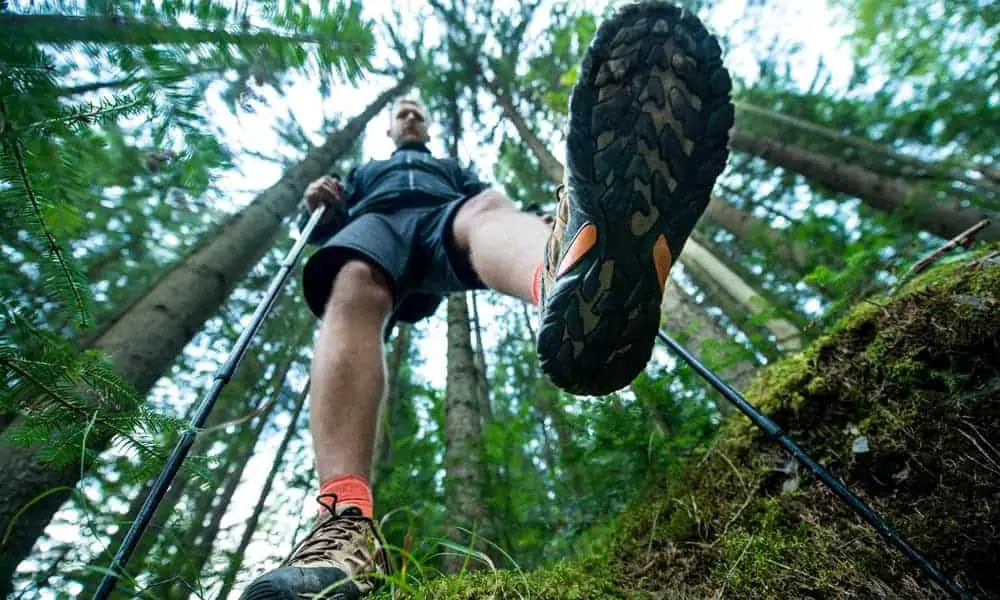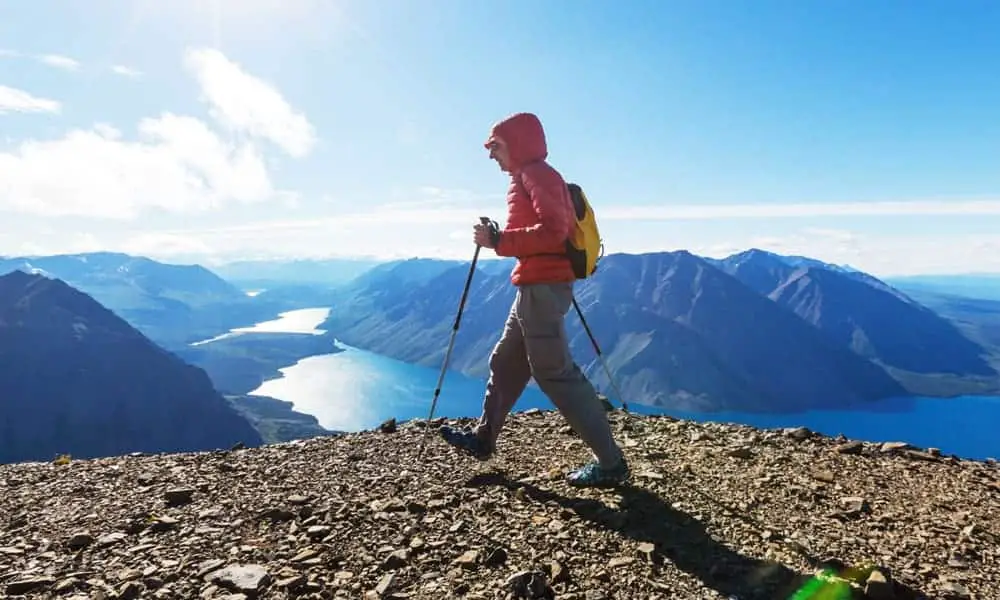Whether you’re in the market for a new pair of hiking boots or simply wondering how to get the most out of your current pair, there might be one question on your mind – how long do hiking boots last?
Here, we’ll examine this popular question and let you know some popular methods for prolonging the lifespan of your favorite hiking boots. They are an investment, and you want to get the most from that investment. We’ll show you how.
How Long Do Hiking Boots Last?
As you can probably guess, there is no simple answer to this question. It depends on many different factors, all of which influence the lifespan of a hiking shoe.
A quality hiking boot should generally last you at least 600-700 miles with an upper limit of roughly 900-1,000 miles. This is considered the average range or lifespan for a good pair of boots. Of course, this average isn’t quite as useful if you want to understand how long your pair of hiking boots will last.
To understand how long your boots are going to last, it’s best to consider the following factors:
The Boots
Obviously. One of the most important factors in determining the lifespan of a pair of hiking boots is the boots themselves. As with any type of outdoor gear, the best hiking boots are built with more reliable construction and will last longer than other brands.
You can find boots with all sorts of unique features and types of construction. This includes different soles, materials, lacing systems, and much more.
We don’t have time to cover all the different types of hiking boots, but there are a few general features that you can look for in a pair of long-lasting boots. Look for materials that are meant to be flexible and durable, such as synthetic or strong leather. Search for a boot that advertises “compression resistance,” or one made with materials such as polyurethane plastic.
It also helps if the boots feature a protective rand to further insulate the toes or heel against splitting. Boots that utilize TPU welding also tend to hold their form better and longer as well.
There’s a lot to look for, with different brands all claiming to be the “most” durable or the “longest lasting.” As long as you buy a quality boot from a reputable manufacturer, you should be fine.
Find out 🥾 Are Timberlands Good for Hiking?
How You Use Them

Of course, it’s not only the boots, it’s how you use them. Needless to say, if you use your boots for more intensive purposes, they won’t last as long. If you’re a casual hiker, your boots may last you many years. But if you’re an experienced trekker/backpacker/mountaineer, your hiking boots will start to degrade much faster.
Therefore, the lifespan of your boots will always need to be considered alongside how you plan to use them.
Additionally, you need to choose a pair of boots that is suited to the terrain you are trying to hike. Boots will have a shorter lifespan if you buy boots which are meant for a different purpose than you use them for. For example, a trail runner serves a very different purpose than a hiking boot, and each have very different purposes and are better suited to long-lasting performance if you use them for their intended purpose.
Your Weight/Height
Your physical attributes will also affect the performance of your boots. Those who are taller or heavier will tend to wear out boots faster, as more pressure is applied to the boots with each step.
However, this isn’t the only physical attribute that can quickly wear out a shoe. Some will find that their walking style causes shoes to wear out faster or slower. For example, if you walk by putting a lot of pressure on the inside of your heel, then you might start to see these areas of a shoe wear out faster.
And More!
Essentially, what we’re trying to say is there are many factors which might cause your boots to wear out more quickly. Try not to stress about these too much. As long as you buy a quality pair of boots then you should get quality usage out of your boots for many hikes to come.
How to Extend the Life of Hiking Boots?
Now, we’ll show you how to slow or even reverse the wear and tear on your shoes. Here are some tips for extending the life of your boots:
Find the Right Brand
Extending the life of your hiking boots starts right at the purchasing process. Buying long-lasting boots is probably the best thing you can do to ensure yourself long-lasting usage.
Look for a trusted brand (Columbia, LL Bean, Timberland, KEEN, etc.), and find a boot that advertises rugged, durable construction. As we mentioned above, look for features such as compression resistance, toe and heel rands, and a durable material such as PU plastic for certain components.
Find out 🥾 Are Timberlands Good for Hiking?
Find the Right Fit
Finding the right boot is only half the battle – you also need to make sure it fits properly! The best thing you can do is get professionally sized by a footwear specialist. Hiking boots need to fit snugly around your ankles, but not so snugly that your feet are unnecessarily constricted. You also need enough room at the toe to wiggle your toes.
If a boot is too small, it might wear out faster, as your feet stretch the boot from within. Not to mention the additional comfort and performance you receive from a boot that fits you properly!
Care for Your Boots
Finally, once you’ve purchased the perfect boots, you need to care for them properly. Caring for your boots is perhaps the biggest influence that you can have over their lifespan. It’s important that you develop a routine for after you hike.
Your boots will get dirty, muddy, and wet. Mud and dirt will dry and, in turn, dry out the material on your boots. This will cause the materials to degrade faster, decreasing the lifespan of the boots. This is especially true if you have stepped in any salt. But if you properly address this issue, you can minimize its effect on your boots’ lifespan.
It’s not as complicated as you might think. First, take a cloth and some warm water and wipe your boots clean. Brush off the dirt and the mud until they are looking fresh. Don’t use too much water, because you don’t want to soak your boots. Just use enough to get off surface-level dirt and mud. Some also prefer to use a stiff footwear brush for this job.
If you have a traditional leather boot, you can even purchase a leather-cleaning kit. These kits include a solution/tool for cleaning the boot, and they also include a sealant for keeping them clean. This waterproofing sealant will repel water throughout your hike, keeping your boots dry and prolonging their lifespan.
How Do I Know When It’s Time to Replace My Boots?

So, you think your boots might be nearing the end of the road. Even if you do everything right, no boots will last forever. But sometimes it’s difficult to tell whether you should get new boots. Here are some tricks for telling when it’s time:
Cracking Midsole: If your boots start to develop a cracking midsole, then this is a sign that it’s time for new boots! Simply put, a cracked midsole won’t offer the support you need for long hikes. It lacks the integrity to adequately support your feet at this point, which will lead to additional fatigue and foot pain.
Frayed Laces: Frayed laces aren’t necessarily a sign that it’s time for new boots, but they are a sign that they may be approaching the end of their shelf life. Laces are designed to last roughly the same amount of time as the boots themselves. Therefore, if the laces are starting to fray, it’s a sign the boots may follow. You should investigate for any of the other warning signs at this point.
Worn Insoles: If the insoles on your boots are starting to wear, then it’s likely time to replace your boots. These insoles are crucial for supporting your feet during long hikes. Sometimes, you will be able to get new insoles instead of replacing the boots entirely. However, a worn-down insole is likely a sign that your boots are going to be worn-down in other areas as well.
Worn-down Soles: Finally, we come to the soles of your shoes. Basically, if the tread is worn to the point where it is barely visible, then it’s time to replace your hiking boots. Not only will these boots be unable to generate adequate traction, they will also lack the support that is provided by a proper sole. There are circumstances where you may want to consider resoling your hiking boots.
Final Thoughts
Thanks very much for checking out our guide to hiking boot longevity. We started with a simple question – how long do hiking boots last? We hope we have given you more than just a simple answer. Follow our guide to get the absolute most out of your boots, and to make sure they hold up for many hikes to come!






